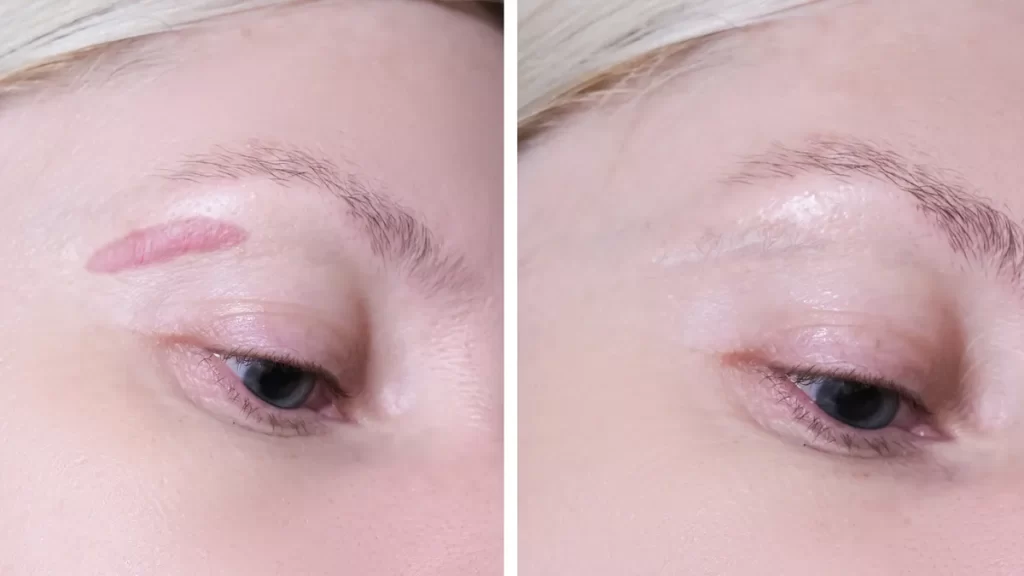Did you know that about 80% of people experience various scars at some point in their lives? Laser scar removal treatment offers an effective solution for reducing the appearance of cutaneous scarring. This advanced procedure uses focused light technology to target scar tissue and new scars, promoting smoother and clearer skin and improving scars appearance.
Whether you’re dealing with acne scars, surgical marks, or injury-related blemishes, laser treatments can help. It’s a non-invasive method with minimal downtime, making it a convenient option for many. Discover how this treatment can boost your confidence, improve your skin’s appearance, and provide scar results.
Understanding Scar Formation
What Are Scars
Scars are marks left on the skin after an injury heals. They form as part of the body’s natural healing process, affecting scars appearance and scar treatment. When the skin is injured, the body produces collagen fibers to repair the damage. These fibers create a new layer of skin, which often looks different from the surrounding area.
Types of Scars
There are several types of scars. Keloid scars are raised and grow beyond the original injury site. They can be itchy or painful. Hypertrophic scars are also raised but stay within the boundaries of the injury. They may improve over time. Atrophic scars are sunken and appear as depressions in the skin. Examples include acne scars like rolling or pick scars.
Factors Influencing Scar Formation
Many factors influence how scars form. Skin type plays a big role; darker skin tones are more prone to keloid and hypertrophic scars. The location of the injury affects scar appearance too. Areas with more tension, like shoulders or chest, tend to develop thicker scars.
Proper wound care can minimize scar formation. Keeping wounds clean and moist helps them heal better. Using silicone sheets or gels can reduce scar tissue formation. Avoiding sun exposure prevents darkening of scars.
Scar Characteristics
Scars have different characteristics based on their type and location. Surface scars are usually flat and blend well with surrounding skin. Deep scars penetrate multiple layers of skin and may affect movement if near joints. Rolling scars create a wavy texture on the skin surface.
Hypertrophic scars are thick and red initially but may fade over time. Keloids continue to grow even after the wound has healed completely, sometimes causing discomfort or pain. Atrophic scars, like those from acne, appear pitted or depressed.
Emotional Impact
Scars can have an emotional impact on individuals. Visible scars might affect self-esteem and confidence. Traumatic scars from accidents or surgeries can be reminders of painful experiences.
Exploring Laser Scar Removal
Non-invasive Procedure
Laser scar removal is a non-invasive cosmetic procedure. It uses focused light to improve the appearance of scars. Unlike surgical methods, it doesn’t require incisions or stitches.
This treatment involves using lasers to remove the outer layer of skin. The laser stimulates new skin growth underneath. This helps in diminishing scars over time.
Minimal Downtime
One major benefit is minimal downtime. Patients can resume daily activities soon after the procedure. There is also a reduced risk of complications compared to surgical options.
Most patients experience some redness and swelling. These side effects usually subside within a few days.
Types of Scars Treated
Laser therapy is effective for various types of scars. Acne scars are common targets for this treatment. It smooths the skin and reduces the depth of these scars.
Surgical scars can also be treated with lasers. This includes scars from operations like appendectomies or C-sections. Laser resurfacing can make these scars less noticeable.
Injury scars respond well to laser treatments too. Whether from accidents or burns, lasers can help improve their appearance.
Acne Scars
Facial acne scars are particularly challenging. Laser scar removal offers a solution for these difficult scars. Fractionated CO2 laser skin rejuvenation is often used for this purpose.
This method breaks down scar tissue and promotes new collagen growth. Over multiple sessions, the skin becomes smoother and more even-toned.
Surgical Scars
Surgical scar revision through laser treatments is gaining popularity. It provides an alternative to traditional scar revision surgery. Lasers can target both old and new scars effectively.
Patients often see significant improvements in the texture and color of their surgical scars.
Injury Scars
For superficial scars caused by injuries, laser treatments are highly effective. These include minor cuts, scrapes, and burns that have left marks on the skin.
The treatment helps in reducing the visibility of these scars, making them blend better with surrounding skin.
Keloid Scars
Keloid scars are raised and thickened areas of skin that form over wounds. They can be particularly stubborn to treat. Laser treatments can help flatten these keloids and reduce their size over time.
This option provides relief for those who find keloid scars unsightly or uncomfortable.
Scar Treatment Options
There are several scar treatment options available through laser therapy:
-
Fractionated CO2 laser
-
Pulsed dye laser
-
Erbium YAG laser
Each type has its unique benefits and is chosen based on the specific scar being treated.
How Laser Treatment Works
CO2 Laser Therapy
CO2 laser therapy is a common method for scar removal. It uses carbon dioxide lasers to remove thin layers of skin. The laser targets the scarred tissue with high precision. This ensures that the surrounding skin remains undamaged.
The process involves breaking down scar tissue. The laser’s heat energy vaporizes the top layers of the skin. This action stimulates collagen production. Collagen is a protein that helps in skin repair and regeneration.
Fractional Laser Therapy
Fractional laser therapy is another effective treatment. It works by creating tiny columns of thermal damage in the skin. These micro-injuries trigger the body’s natural healing process. Like CO2 lasers, fractional lasers also stimulate collagen production.
This method allows for quicker recovery times. The untreated areas help in faster healing. Fractional lasers are ideal for treating deeper scars without extensive downtime.
Precision Targeting
Laser treatments are highly precise. They focus only on the scarred tissue. This minimizes damage to healthy skin. The laser’s energy is absorbed by the water in the skin cells. This leads to controlled heating and removal of the damaged layers.
Such precision is crucial for effective treatment. It reduces the risk of side effects like hyperpigmentation or infection.
Collagen Stimulation
Collagen plays a vital role in improving scars. Laser treatments stimulate collagen production in the treated area. Increased collagen helps to smooth out scars and improve skin texture.
With more collagen, the skin becomes firmer and more elastic. Over time, this results in a noticeable improvement in the appearance of scars.
Single vs Multiple Treatments
A single laser treatment may not be enough for severe scars. Multiple sessions are often required for optimal results. Each session builds on the previous one, enhancing collagen production and further breaking down scar tissue.
Patients usually notice gradual improvements after each session. The number of sessions depends on the severity and type of scar.
Preparing for Laser Therapy
Choosing a Doctor
Select a qualified dermatologist or cosmetic surgeon. Check their credentials and experience with laser procedures. Look for board certification in dermatology or cosmetic surgery. Ask about their specific experience with laser scar removal treatments. Ensure they use updated equipment and techniques.
Pre-Treatment Consultation
A pre-treatment consultation is crucial. The doctor will assess your skin type and scar characteristics. This helps determine the best laser therapy, such as fractional laser therapy or CO2 laser therapy. They will discuss your medical history and any medications you are taking. This ensures the treatment’s safety and efficacy.
Skin Type Assessment
Different skin types react differently to laser therapy. Lighter skin typically responds better to certain lasers. Darker skin may need special consideration to avoid pigmentation issues. The doctor will use this assessment to choose the most appropriate laser.
Scar Characteristics
The type of scar matters too. Raised scars may require different treatment than flat ones. Deep scars might need more sessions. The doctor’s evaluation will guide the choice of light beams used in the therapy.
Suitability for Laser Therapy
Not everyone is suitable for laser therapy. Certain health conditions can affect healing. For example, people with active acne or infections should wait until these issues are resolved. The doctor will advise if laser therapy is right for you.
Pre-Treatment Care Instructions
Follow specific instructions before undergoing laser therapy:
-
Avoid sun exposure for at least two weeks before treatment.
-
Use sunscreen daily if you must go outside.
-
Stop using retinoids or other topical medications that may irritate the skin.
-
Avoid aspirin and other blood-thinning medications to reduce bruising risk.
-
Stay hydrated and maintain a healthy diet to support healing.
Avoiding Sun Exposure
Sun exposure can increase the risk of complications. UV light can make your skin more sensitive to the laser. It also increases the chance of pigmentation changes post-treatment.
Medication Considerations
Certain medications can affect how your skin heals after laser therapy. Retinoids can make your skin more sensitive. Blood thinners like aspirin can increase bruising risk. Discuss all medications with your doctor.
What to Expect Post-Treatment
Recovery Time
Recovery time varies for each person. Most people see improvement within a few days. Full healing can take a few weeks. The treated area may look red and swollen at first. This is normal and should subside in a few days.
Care Instructions
Proper care is crucial after laser scar removal treatment. Clean the treated area gently with mild soap and water. Avoid scrubbing or using harsh products. Moisturize the area regularly to keep the skin hydrated.
Redness and Swelling
Temporary redness and swelling are common after treatment. These symptoms usually last for a few days. Applying a cold compress can help reduce swelling. Over-the-counter pain relievers may also be used if needed.
When to Contact a Healthcare Provider
Though redness and swelling are normal, some symptoms may require medical attention:
-
Severe pain
-
Excessive swelling
-
Signs of infection (e.g., pus, fever)
Contact your healthcare provider if you experience any of these symptoms.
Possible Complications
Common Side Effects
Laser scar removal can cause some common side effects. These include temporary redness, swelling, and discomfort. Redness usually fades within a few days. Swelling may last longer but typically subsides within a week. Discomfort is often mild and can be managed with over-the-counter pain relievers.
Less Common Complications
e complications are less common but still possible. Infection can occur if the treated area is not kept clean. Changes in skin pigmentation might happen, especially in people with darker skin tones. This can result in lighter or darker patches on the skin. Scarring is another potential risk, though it is rare.
Preventive Measures
To minimize risks, follow these preventive measures:
-
Keep the treated area clean and dry.
-
Avoid sun exposure to prevent pigmentation changes.
-
Use prescribed creams to aid healing.
Managing Side Effects
If side effects occur, several treatments can help manage them. For redness and swelling, cold compresses can provide relief. Over-the-counter medications like ibuprofen reduce inflammation. For discomfort, topical anesthetics may offer temporary relief.
Addressing Infections
Infections need prompt attention. Signs include increased redness, swelling, and pus. If any of these symptoms appear, contact your doctor immediately. Antibiotics may be necessary to treat the infection effectively.
Pigmentation Changes
Pigmentation changes can be managed with specific treatments. Topical creams containing hydroquinone or retinoids help lighten dark spots. Laser treatments can also address pigmentation issues. Consult your dermatologist for the best course of action.
Preventing Scarring
Scarring prevention involves proper aftercare. Avoid picking at scabs or scratching the treated area. Keeping the skin moisturized helps in healing. Silicone gel sheets or ointments can also reduce the risk of scarring.
When to Choose Laser Treatment
Non-surgical Option
Laser scar removal is ideal for those seeking a non-surgical option. It improves the appearance of scars with minimal downtime. Traditional methods like surgery involve longer recovery times. Laser treatments allow patients to return to their daily activities quickly.
Nonablative laser treatment is a popular choice. It targets deeper layers of the skin without damaging the surface. This makes it less invasive compared to other methods.
Resistant Scars
Consider laser treatment for scars resistant to other treatments. Topical creams and dermabrasion might not always work. Scars that persist despite these treatments may respond better to lasers.
Laser skin treatments can be more effective in breaking down scar tissue. They stimulate collagen production, which helps in healing and reducing scar visibility.
Dermatologist Consultation
Consulting with a dermatologist is crucial. They evaluate if laser treatment suits your specific case. Factors like the scar’s age, type, and location matter.
A dermatologist can recommend the best laser type for your scar. They assess whether nonablative or ablative lasers are more suitable.
Different Scar Types
Different scar types respond differently to laser treatments. Acne scars, surgical scars, and injury scars are common candidates. Each type requires a tailored approach.
Nonablative lasers work well on mild to moderate scars. Ablative lasers might be needed for deeper or more severe scars.
Age of Scars
The age of the scar influences treatment effectiveness. Newer scars often respond better to laser treatments. Older scars might need multiple sessions for noticeable improvement.
Dermatologists can determine the optimal timing for treatment based on scar age.
Scar Location
The location of the scar also plays a role. Facial scars are often treated with lasers due to their visibility. Body scars can also benefit but might require different settings.
Areas with thinner skin may need gentler laser settings to avoid complications.

When to Avoid Laser Therapy
Active Skin Infections
Avoid laser therapy if there are active skin infections. The heat from the laser can worsen the infection. Bacteria and viruses might spread, causing more damage.
For example, acne breakouts or cold sores can flare up. Consult a dermatologist before proceeding with treatment.
Certain Skin Disorders
Individuals with certain skin disorders should be cautious. Conditions like psoriasis or eczema can react negatively to lasers. The treatment may cause flare-ups or worsen symptoms.
Keloid scars also pose a risk. These raised scars can become more pronounced after laser therapy. Always discuss your medical history with a healthcare provider.
Very Dark Skin Tones
People with very dark skin tones face higher risks. Lasers target pigment in the skin, which can lead to complications. Hyperpigmentation or hypopigmentation are common issues.
These conditions cause uneven skin tone. Dark spots may become lighter, or light spots may become darker. Specialized lasers exist but are not always effective.
Pregnant Women
Pregnant women should postpone laser treatments. Hormonal changes during pregnancy can affect skin sensitivity. The safety of laser therapy for pregnant women is not well-studied.
Postponing treatment until after childbirth is safer. Always consult an obstetrician before considering any cosmetic procedures during pregnancy.
Medications Increasing Light Sensitivity
Certain medications increase light sensitivity. These include antibiotics like tetracycline and isotretinoin for acne treatment. Using lasers while on these medications increases the risk of burns and blisters.
Wait until you have finished the medication course. Discuss alternative options with your doctor if immediate treatment is necessary.
Realistic Expectations
Having realistic expectations is crucial. Laser therapy will not completely remove scars. It significantly improves appearance but leaves some marks behind.
Understand that multiple sessions might be needed. Results vary based on scar type, age, and skin type. Consulting a qualified professional helps set realistic goals.
Summary
Laser scar removal treatment offers a promising solution for those looking to minimize unsightly scars. By understanding the process, preparing properly, and knowing what to expect, you can make an informed decision about whether laser therapy is right for you. While there are potential complications, the benefits often outweigh the risks for many.
Ready to take the next step? Consult with a certified dermatologist to explore your options and get personalized advice. Don’t let scars hold you back. Embrace smoother, clearer skin and boost your confidence today!
Frequently Asked Questions
What is laser scar removal treatment?
Laser scar removal uses focused light therapy to reduce the appearance of scars. It works by stimulating new skin growth and breaking down scar tissue.
How does laser treatment work for scars?
Laser treatment targets the scar tissue with concentrated light. This breaks down the tissue and promotes new, healthy skin growth.
Is laser scar removal painful?
Most patients experience minimal discomfort during laser scar removal. A topical anesthetic is often applied to reduce any pain.
How should I prepare for laser therapy?
Avoid sun exposure and discontinue certain medications before treatment. Follow your doctor’s specific pre-treatment instructions.
What can I expect after a laser scar removal session?
Post-treatment, you may experience redness, swelling, or minor irritation. These effects typically subside within a few days.
Are there any risks associated with laser scar removal?
Possible complications include infection, changes in skin color, and scarring. Always consult a qualified professional to minimize risks.
When should I consider laser treatment for my scars?
Consider laser treatment if your scars are causing emotional or physical discomfort. Consult with a dermatologist to determine if it’s right for you.





